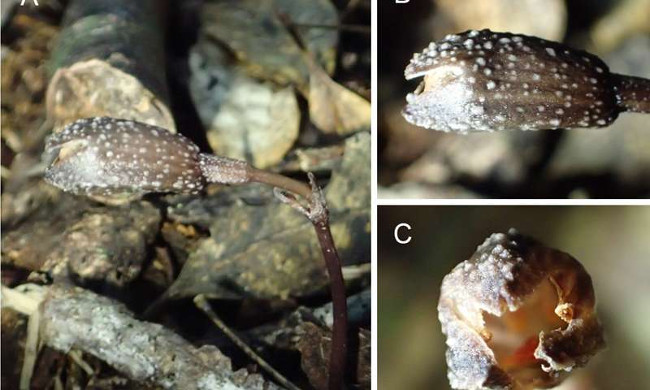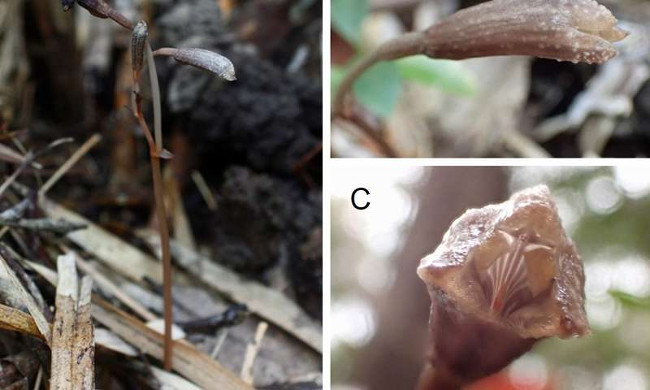Two new species of parasitic plants discovered in Okinawa
Two new species of parasitic plants have just been discovered on Okinawa Island, Japan, discovered and established directly by Professor SUETSUGU Kenji (Kobe University School of Engineering Science), receiving the attention of many people.
Accordingly, they in turn are named Gastrodia nipponicoides and Gastrodia okinawensis . This information has just been published in Phytotaxa Online Magazine on April 7, 2017.
Previously, speaking of photosynthesis, it was one of the criteria for determining flora. However, in nature there are still some types based on the parasitic form to live in the form of mushrooms and absorb nutrients on the host plant. In addition to fungi, these types of vegetative vegetation are often called mycoheterotrophs.
 Two new species of parasitic plants discovered in Okinawa Picture 1
Two new species of parasitic plants discovered in Okinawa Picture 1
Because it does not directly participate in photosynthesis, only parasites suck a bit of nutrients, so these two new parasitic plants only grow in a short period of time, can produce flowers or some fruit then disappear.
There are many types of parasitic plants of this type, very small and hard to find in nature, even forests in Japan or around the world. Professor Suetsugu said in a statement.
Professor Suetsugu discovered two parasitic plants Gastrodia nipponicoides and Gastrodia okinawensis on Okinawa tropical island in a natural field survey with independent biologists including Mr. Masakazu NAKAMA, Mrs. WATANABE Tazuko and WATANABE Mr. Hiromitsu. After the discovery, the group was supported by independent researchers, Mr. TOMA Tsugutaka, Mr. ABE Atsushi (researcher from the Okinawa Churashima Foundation), and Professor MORIGUCHI Mitsuru (Humanities Department of Okinawa University). as well as establishing new species.
 Two new species of parasitic plants discovered in Okinawa Picture 2
Two new species of parasitic plants discovered in Okinawa Picture 2
The study showed that both of these new parasitic plants have many characteristics related to the strains of Gastrodia nipponica, belonging to Orchidaceae family. However, the biggest difference is the lip contour on the petals and the calyx, where the combination of stamens, petals, pistils, biological parts of flowers.
The measured dimensions show that Gastrodia nipponicoides is 3-6cm in size, with 1-4 black brown flowers, a 15mm long flower (Figure 1). In it, G. okinawanesis plants are 10-17cm tall, with 1-4 light brown flowers, each about 20mm long (figure 2).
Previously, the team also found a new species called Mycoheterotrophs also parasites in the ecosystem of this forest. Contribute to creating a diverse and rich ecosystem that we have not yet discovered. And there may be a very small, very underground ecosystem that we can't discover or see with the naked eye.
In the year outside, Yanbaru forest was established as Yanbaru National Park with two more newly discovered species playing a very important role in this habitat.
You should read it
- Japan's oldest human skeleton has just been found in Okinawa
- The most exotic plants on Earth
- Up to 8.9 km2, this is the most giant creature on Earth ever known
- Image of the blossoming flower - Love is incomplete
- 10 most beautiful flowers in the world
- The unique flower arrangement patterns to discuss the Tet festival's day and fortune
- The parasite eats, sleeps, mates and dies on the face of humans
- Discover new snake species in Con Dao
- Synthesis of the most beautiful flower images
- How to make an eye mask in a strange 'parasite'
- 8 most expensive flowers on the planet, money is not sure to buy
- 3 super beautiful flower arrangements for clumsy people on March 8
May be interested

It turned out that the octopus gave up its ability to evolve to become smarter

Humans are not the only species with fingerprints

Mysterious lake 'death' in Africa robbed more than 1700 lives in one night

20 animals are so strange that you don't believe they exist on Earth (part 2)

The list of 'horror' mosquitoes does not bother to suck human blood

Is the Antarctic once covered by lush subtropical forests?






 New plant species discovered in China
New plant species discovered in China 7 species of plants have special abilities like humans
7 species of plants have special abilities like humans The mystery of the 'ghost tree' poisoning itself in exchange for nutrients
The mystery of the 'ghost tree' poisoning itself in exchange for nutrients DNA testing shows an extinct plant species
DNA testing shows an extinct plant species Plants feel pain when they are eaten and have a defense mechanism against it
Plants feel pain when they are eaten and have a defense mechanism against it 11 species of lethal poisonous plants that we should avoid
11 species of lethal poisonous plants that we should avoid